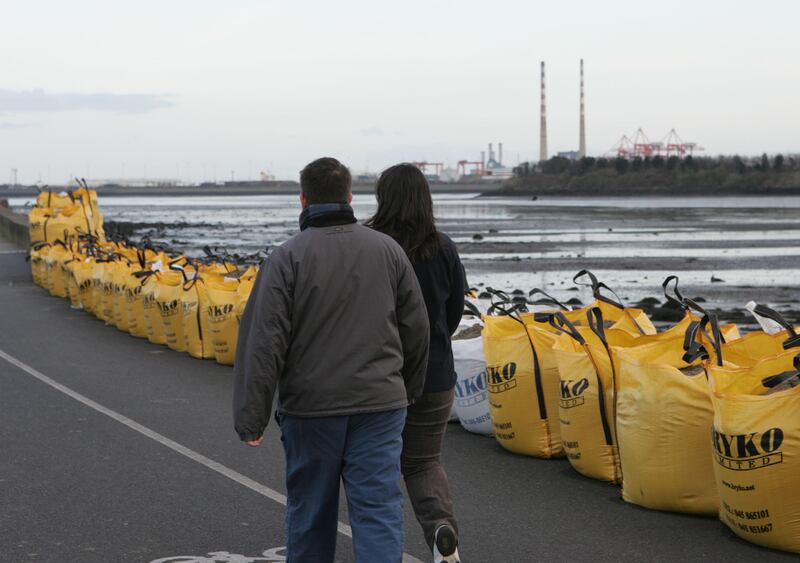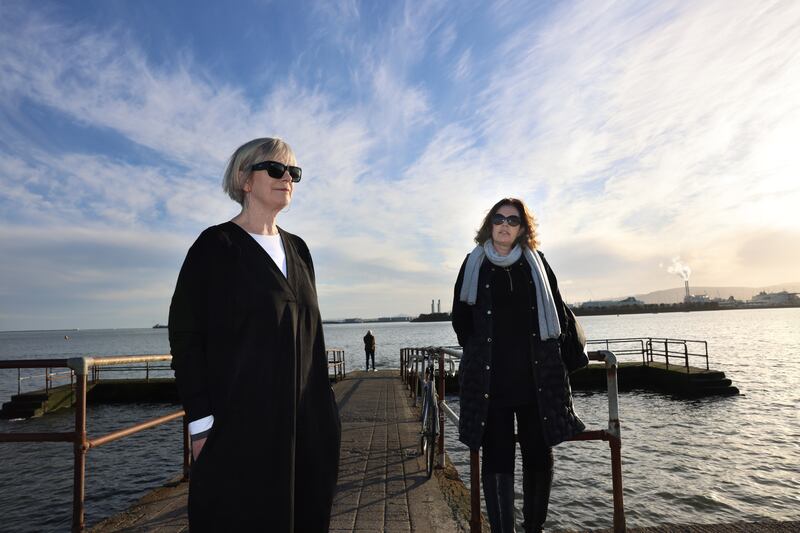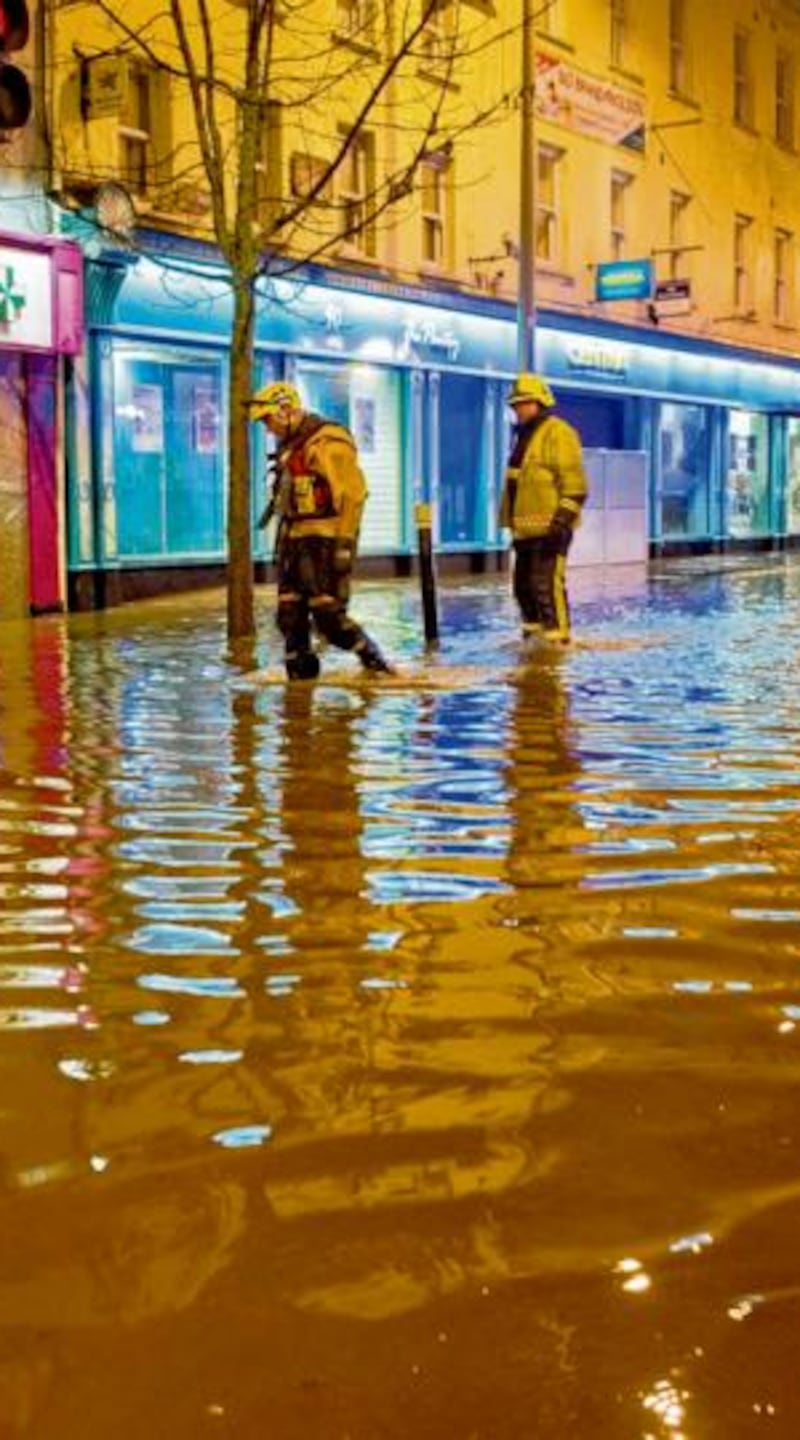Irish people have always been drawn to the water. Just as the earliest settlers made their homes close to rivers or the coast, today 40 per cent of the population lives within 5km of the coast. A sea view or proximity to a river is a desirable asset, reportedly adding anywhere between a third and half to the value of a home.
But rising sea levels and more extreme weather events may one day turn some of those assets into liabilities. The sea level in Dublin and Cork is rising at around double the global rate, much faster than predicted. Inland, more frequent extreme weather events means more fluvial – or river – flooding.
The Government is making plans to mitigate against rising floodwaters. It has committed €1.3 billion over the lifetime of the National Development Plan to protect 23,000 properties. Work on 80 per cent of vulnerable properties is under way or completed.
Everyone seems to agree something needs to be done, but there is no unanimity on the best way forward
Over the coming years, more of Ireland’s waterside cities, towns and villages may face difficult and sometimes divisive decisions about how the remaining money should be spent.
READ MORE
Two of the locations identified by the Office of Public Works (OPW) as being under imminent threat – Blackpool, to the north of Cork City, and Clontarf, in north Dublin – are waiting for urgently required work to begin.
One is a former industrial village with the oldest population of any electoral ward in Cork, a place where a two-bedroom cottage can still be bought for around €159,000. The other is an affluent coastal suburb of Dublin where the average price of a home is more like €850,000. The two areas may not have much in common at a superficial glance, but both are facing the same kind of tensions that have led to the stalling of flood defence schemes.

Blackpool is getting another heavy soaking in a month of what feels like ceaseless rainfall. The river Bride, brown and swollen, roils furiously alongside the car park at Orchard Court the main street, before vanishing under a culvert. The walk alongside the fast-flowing river might be picturesque were it not for the mounds of rubbish strewn at intervals. I see a garden light, some construction materials, split plastic bags of clothes, garden furniture, nappies. For some, it is clear that the river is not a natural amenity or even a threat so much as a moving skip.
The Bride briefly thunders back into view opposite the Daybreak shop and O’Shea’s pharmacy, before it disappears again under a bridge. It doesn’t look like it will take much more for the river to breach its banks, as it has – with catastrophic results – in 2002, 2012 and again nine months later, in 2013.
I’ve been trying to deal with flooding for the last nearly 30 years. I got septicaemia from trying to clean up the river and I ended up in ICU. I had my family trapped inside the building back in 2013 during the flooding
“You’d be surprised. It can get a lot higher than this,” says Chris Moody, whose own house backs on to the river further up, above the flood line.

After the 2013 floods, Cork City Council removed a tractor tyre along with a tangled mass of vegetation from the river. Later, two local business owners – pharmacist Tadhg O’Leary and Jer Buckley who owned the Daybreak – put on their wet gear and went in under the plaza themselves. They pulled out mattresses, washing machines, shopping trolleys, bikes and radiators. In 2015, professional contractors sent in by Cork City Council retrieved over 27 tonnes of debris from one small area under the plaza.
Since the rubbish and trash screens were removed, the village has not been flooded by the Bride, though it has come terrifyingly close on a number of occasions. A couple of weeks before I visit, it flooded again – this time a blocked drain was the culprit.
The potential benefit ... in reducing peak flows at Blackpool will diminish as climate change takes hold. This means that it is unlikely to be a long-term solution in itself
The fear that it could flood again is palpable. Flood insurance has become difficult to get for home and business owners in the town. Here, as in other parts of the country, everyone seems to agree something needs to be done, but there is no unanimity on the best way forward.
The first draft flood plan for Cork, published in 2010, didn’t even include a scheme for Blackpool, as the flood risk was not considered significant. But the major floods of 2012 and 2013, when the waters rose up to four feet high and affected 15 businesses, convinced the OPW that flood protection was “a critically required infrastructural investment.” It looked at four options and eventually settled on one which involved culverting a 350m section of the river where it flows through Orchard Court. The scheme was initially due to cost €14 million, but is now expected to cost €20.5 million. It was formally approved in March 2021.
But those plans stalled when the State conceded to further public consultation following a judicial review by a local group, led by Moody.
In Blackpool, this has become a story of what happens when the environmental havoc caused by the climate crisis collides with the rights of embattled business owners and the needs of a community of protected otters.

Chris Moody doesn’t look at the river which flows along the bottom of his garden and immediately see a threat. Instead, what he sees is a vibrant ecosystem. Specifically, he sees the home of the otter.
A Cork Urban Otter survey carried out between 2011 and 2012 found a minimum population of 11 otters living along the Lee and its tributaries. The OPW environmental impact study on the Blackpool scheme concluded that “the impact on otters is considered as a slight negative impact.”
“It is irrefutable that this river is important for otters,” Moody says. One night recently, he heard otter sounds from his bathroom and was able to film a mother and cub in the river behind his house. “To me, it’s a mad idea to cover over a river. It’s just a mad, crazy idea.”
His argument is not that nothing should be done but that, “there are viable alternatives” to the culverting plan. The campaign he was involved in setting up, Save Our Bride Otters (SOBO), was granted leave in June 2021 to apply for judicial review of the decision by the Minister for Public Expenditure to approve the flood relief scheme. In January 2022, the State agreed to further advanced public consultation.
This is the culmination of unjust, unsustainable, feckless planning
The OPW said in a statement many potential solutions were considered during the development of the scheme, but the scheme that emerged ultimately best met the full range of scheme criteria and objectives. Further information was submitted to the Department of Public Expenditure in October and will now be subject to a further public consultation in relation to the scheme. A procurement process for a contractor will follow in 2023.
SOBO argues that the OPW should revisit another proposal that was discounted – upstream storage, which would involve establishing a safe floodplain upriver and restricting the volume of water that flows into the village. However, the OPW’s own report on upstream storage found that “the potential benefit ... in reducing peak flows at Blackpool will diminish as climate change takes hold. This means that it is unlikely to be a long-term solution in itself”. However it may be revisited in future as part of a further climate change adaptation strategy.
Moody believes not enough consideration was given to the environmental impacts of the culverting plan. “We say all these things here about protecting biodiversity, that there’s a biodiversity crisis, it’s a climate crisis. Yet, when the push comes to shove, that doesn’t matter.”
His house is above the flood zone, he acknowledges. “I feel very attached to [the river], you know, and it would be devastating to see it covered over and gone ... I have complete sympathy for [the business owners who have] been flooded. I don’t blame them. I know they’re not happy with the likes of me coming along and saying that, you know, there are otters in the river and we should look after the river. But I believe in what’s fair and what’s just. This is the culmination of unjust, unsustainable, feckless planning.”
Twenty years ago, the town flooded on a Wednesday. The people got all their furniture back in, and it flooded again on the Monday
“The otters will find somewhere else,” says Jer Buckley, drinking tea in an office over O’Shea’s pharmacy, run by his friend Tadhg O’Leary. “We had a shopping centre here and a major bypass built here. Were the otters upset? Of course they were upset. But they went up the river, and they came back down again. What we’re really talking about is a roughly 350m stretch of the river, which is in the middle of a housing estate, out of a river that runs for over 50 miles.”
He has little time for the suggestion that upstream storage could offer an easier, cheaper solution, pointing out that it was discounted by the OPW on the grounds that it was not sufficiently future-proofed and might lead to problems for residents of the proposed storage area. “We believe the solution for flooding will come from the body responsible for flooding in the country which is the OPW.”
He says people focused primarily on environmental concerns perhaps “don’t understand what it is like to have a river run through your house. I’ve been trying to deal with flooding for the last nearly 30 years. I got septicaemia from trying to clean up the river and I ended up in ICU. I had my family trapped inside the building back in 2013 during the flooding. So I don’t think it is an acceptable stance to take to put otters in front of people.”
“If your home or your business has ever been flooded, you’ll get this awful feeling of being overwhelmed with negativity. But you get a sense of empowerment from taking action
O’Leary describes was the people of Blackpool have faced over the last 20 years. “Twenty years ago, the town flooded on a Wednesday. The people got all their furniture back in, and it flooded again on the Monday.”
Nine months later, the town flooded again. When the blocked drain caused a sudden flood a couple of weeks ago, “we did keep it out”, which gave them a confidence boost. But living with the constant threat is exhausting.
While they wait for the flood defence scheme to be delivered, O’Leary and Buckley have decided to channel their frustration into action, focusing on building flood resilience in the community. O’Leary has developed an early warning system using a flood gauge involving an old Nokia phone and a simple camera set up in the river, and the Riverspy app, which was built with kayakers in mind. If the peak flow rises above a certain level, he gets a warning texted to his phone.
“And then you put up the flood defences.”

“This is where, I think, the local authorities and the Government are missing a trick,” says Buckley. “Building flood resilience is a huge project. It’s not something that the Government can do on their own. It’s not something the local authorities can do on their own.”
He would like to see towns like his have a flood committee and a plan in place. They need easy, local access to things like sandbags and tools for opening drains. O’Leary and Buckley are constantly on rubbish watch, pulling large items out of the river – something Moody also does. The week before I visit, the front of a Toyota had been thrown in the river. One of the primary appeals of the culverting plan, they say, is that it puts an end to dumping.
We’ve just been really lucky that we haven’t had like high tide, high winds and say heavy rain at the same time. But it could happen. And then we’re all in trouble
The lesson from Blackpool, says Buckley, is that flood resilience empowers communities faced with the worst possible circumstances. “If your home or your business has ever been flooded, you’ll get this awful feeling of being overwhelmed with negativity. But you get a sense of empowerment from taking action. Those small baby steps turned into very big steps for us,” he says.
“As global warming happens, we’re going to have more and more of these floods. So we need to work with the OPW, not fight against them. We need to work with the local authority, not fight against them. And leave the experts come up with the expert solutions.”

You can’t miss the sandbags in Clontarf. They are stretched out for 250m along the coastline like squat, white-uniformed sentries, a jarring visual reminder of the major flooding that happened here in 2002 and 2004. “We don’t even see them any more,” says Liz Farren, the manager of Casa Pasta restaurant on the seafront.
“The customers all complain about the state of them. But we seem to need them because they can’t decide whether a wall should go over there or not.”
A neighbour who runs another business along the seafront wants the sandbags gone, complaining that he has seen rats around them. “Are they going?” he asks Green Party Councillor Donna Cooney, when she calls into his premises. He looks across at them in dismay. “A lot of people say ‘it wouldn’t happen in Sandymount’.”
[ Local warning on delay to €20m Cork flood relief schemeOpens in new window ]
He isn’t too bothered by the threat of flooding. “There’s been nothing here for years.”
“We’ve just been really lucky that we haven’t had like high tide, high winds and say heavy rain at the same time. But it could happen. And then we’re all in trouble,” Cooney tells him.
Later, she explains, “I really do have a sense of urgency, because I actually live in the area that is predicted to be flooded. But I also feel it’s my responsibility as a public representative. I just don’t understand why we’re not getting this done. We’ve escaped major flooding for quite some time. But eventually our luck will run out.”

It’s not as though there has never been a sense of urgency in Clontarf. Here, as in Blackpool, the council secured planning to build flood defences as far back as 2008. The original plan was for a raised earthen bank between the water and the road that would be as high as 2.75m in spots.
But almost 5,000 people turned out to protest, on the basis that it would have cut the homes and businesses along the seafront completely off from the sea and turned the promenade into what Independent Cllr Damian O’Farrell describes as a “tunnel. You could be walking for a kilometre before there is a way out”.
Media headlines suggesting that Clontarf residents were worried about losing their views annoyed many in the area, who say safety of those walking along the promenade – without the “passive security” provided by the view from the nearby busy road – was a far greater concern.

In 2018, a new plan was developed to protect the 400 at-risk properties, involving a dual wall solution, with one low wall at the sea, and a higher one on the footpath along Clontarf Road. “That two wall solution is what we’ve been working on for the last several years,” says Independent Councillor Damian O’Farrell. “Where we are now is the question of what height that [higher] wall would be.”
The Clontarf Residents Association (CRA) is among those concerned that the proposed wall is too high and will detract from the safety of the promenade.
There’s no climate deniers around in this area. We’ve always seen the need for flood defences, but they need to be right
A joint working group (JWG) was formed to try to progress the issue. A presentation to the Council looking at options was due to happen in March 2020, but the pandemic put a stop to that. That presentation – which the Council has stressed is not a new plan – envisaged walls of up to 1.2m along the footpath, with higher demountable barriers for some particularly vulnerable sections. The CRA says it should not exceed 750mm, and that flood defences could be bolstered with self-closing barriers and demountables. In a statement, Dublin City Council said it was in the process of finalising contract documents to appoint a Multi-Disciplinary Consultancy Team, who will develop a preliminary design for the promenade. Those design proposals will go before the JWG in 2023. The scheme could still take four to eight years to deliver, which means the sandbags will be in place for some time yet.
This isn’t just a “Clontarf issue”, says Antoinette O’Neill, an architect and member of the JWG. “We are an island and we have lots of cities that are going to be in the same position.” What happens here could be a test case for other cities, she believes.

“It is a nationwide issue, and it has to be addressed on that basis,” agrees Deirdre Nichol, chairperson of CRA. “There’s no point in deciding a wall will do in Clontarf, and then we move somewhere else on the island and just put in a higher wall. You can’t just build a wall around the whole country.”
Cooney would like to see nature-based solutions, possibly involving using the park as a flood plain and an elevated cycle track that could also act as a flood barrier. It’s time now, she says, for the Council to put out concept designs “and let people have an input. You won’t please everybody all the time.”
We are genuinely very worried that we are now 10 years talking; 10 years trying to talk. Everybody knows the flood is going to come
The one thing every stakeholder seems to be agreed on is that doing nothing is not an option. “We would have to relocate people because this is going to be flooded,” says O’Farrell. “I’ve never come across anybody that doesn’t that doesn’t believe it’s coming. There’s no climate deniers around in this area. We’ve always seen the need for flood defences, but they need to be right. They need to be respectful of the of the receiving environment. We need to look outside the box for solutions. And we need to look at the budget. But it needs to happen quickly.”
Not all of those imperatives are compatible, he accepts. Eventually, it may just come to a point “where flood defences will have to be built, sooner or later.”
“We’ve never said no to flood defences,” says Eilis O’Brien, a member of the JWG. “We said no to a wall that destroys the amenity. We are genuinely very worried that we are now 10 years talking; 10 years trying to talk. Everybody knows the flood is going to come.” But if it’s done right with community agreement “this could be a very good model for other places.”
What flood defences “done right” means in practice is an open question, but it is one that more and more communities are going to have to confront. If the experience of Blackpool and Clontarf shows anything, it is that flood defences schemes are only as effective as the community that support them.
How Ireland will be affected by rising sea levels in the future is not certain. What we do know is that the challenge of how to balance the rights of homeowners in flood zones with concerns about the environmental impact is not going away. But neither is the ticking clock of climate crisis.



















